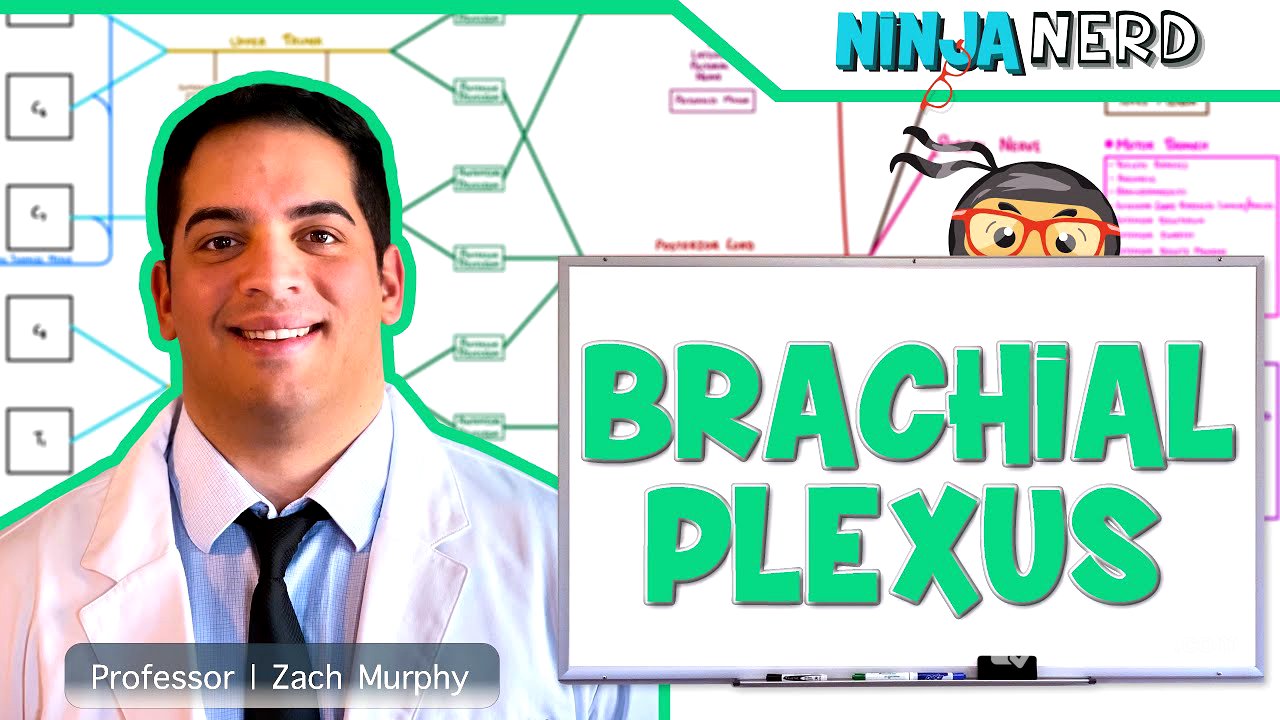TLDR;
This video by Ninja Nerd provides a detailed explanation of the brachial plexus, a network of nerves in the shoulder that carries movement and sensory signals from the spinal cord to the arms and hands. The video simplifies the complex anatomy by using the mnemonic "Remember to Drink Cold Beer, MarMu," which stands for Roots, Trunks, Divisions, Cords, Branches, Musculocutaneous, Axillary, Radial, Median, and Ulnar nerves. It covers the origin and formation of the plexus, its major branches, and the muscles and skin areas they supply.
- The brachial plexus originates from spinal nerve roots C5-T1.
- It is structured into roots, trunks, divisions, and cords before branching into major nerves.
- Key nerves include the musculocutaneous, axillary, radial, median, and ulnar nerves, each serving specific muscles and cutaneous regions of the upper limb.
Introduction to the Brachial Plexus [0:06]
The brachial plexus starts from the spinal cord around C5, potentially gaining branches from C4, and extends down through C6, C7, C8, and T1. The naming convention of C8 is clarified, noting it runs between the first thoracic and seventh cervical vertebrae, accounting for eight pairs of cervical spinal nerves despite only seven cervical vertebrae. To remember the brachial plexus, use "Remember to Drink Cold Beer, MarMu," which stands for Roots, Trunks, Divisions, Cords, Branches, Musculocutaneous, Axillary, Radial, Median, and Ulnar nerves.
Roots and Trunks of the Brachial Plexus [3:01]
The C5 and C6 nerve roots merge to form a trunk, while the C7 root feeds into its own trunk, and the C8 and T1 roots combine to form another trunk. These trunks are named based on their position: the upper trunk (formed by C5 and C6), the middle trunk (from C7), and the lower trunk (from C8 and T1). This arrangement simplifies understanding the initial structure of the brachial plexus before it further divides.
Divisions of the Brachial Plexus [4:24]
Each of the upper, middle, and lower trunks splits into anterior and posterior divisions. These divisions are crucial because specific combinations of them form the cords of the brachial plexus. The upper trunk divides into anterior and posterior divisions, the middle trunk also splits into anterior and posterior divisions, and the lower trunk similarly divides, setting the stage for cord formation.
Cords of the Brachial Plexus [5:52]
The posterior divisions from the upper, middle, and lower trunks combine to form the posterior cord. The anterior divisions of the upper and middle trunks merge to create the lateral cord. The anterior division of the lower trunk forms the medial cord. The median nerve is then formed by branches from both the medial and lateral cords, completing the basic structure of the brachial plexus.
Minor Branches of the Brachial Plexus from the Roots [10:22]
A branch from the C5 root forms the dorsal scapular nerve, which supplies the rhomboids (major and minor) and levator scapulae muscles, responsible for scapular retraction and elevation. The long thoracic nerve, formed by branches from C5, C6, and C7, innervates the serratus anterior muscle, which protracts the scapula. These nerves are essential for shoulder and scapular movement.
Minor Branches of the Brachial Plexus from the Upper Trunk [12:45]
The upper trunk gives rise to the suprascapular nerve, which supplies the supraspinatus (weak abduction) and infraspinatus (lateral rotation) muscles around the shoulder joint. Additionally, the nerve to subclavius innervates the subclavius muscle, which depresses the clavicle. These nerves contribute to shoulder joint function and clavicular movement.
Minor Branches of the Brachial Plexus from the Cords [14:25]
The lateral cord gives off the lateral pectoral nerve, which supplies the pectoralis major muscle. The posterior cord branches into the upper subscapular nerve (supplying the subscapularis for medial rotation), the thoracodorsal nerve (innervating the latissimus dorsi for extension, adduction, and medial rotation at the shoulder joint), and the lower subscapular nerve (supplying both the subscapularis and teres major, which performs similar functions as the latissimus dorsi). The medial cord gives off the medial pectoral nerve (supplying the pectoralis major and minor), the medial brachial cutaneous nerve (supplying the posterior and medial surface of the brachial region), and the medial antebrachial cutaneous nerve (supplying the anterior brachial region and forearm).
Major Branches: Musculocutaneous Nerve [20:45]
The musculocutaneous nerve has both cutaneous and motor branches. The cutaneous branch supplies the lateral forearm, transmitting touch, pain, and temperature sensations. The motor branch innervates the coracobrachialis (flexion and adduction at the shoulder joint), brachialis (flexion at the elbow joint), and biceps brachii (flexion at the elbow joint and supination of the palm).
Major Branches: Axillary Nerve [22:21]
The axillary nerve passes through the quadrangular space around the shoulder joint and has cutaneous and motor branches. The cutaneous branch supplies a patch of skin on the posterior and lateral surface of the deltoid. The motor branch innervates the deltoid muscle (anterior fibers for flexion, lateral fibers for abduction, and posterior fibers for extension at the shoulder joint) and the teres minor (lateral rotation of the shoulder joint).
Major Branches: Radial Nerve [23:51]
The radial nerve is a major nerve with extensive cutaneous and motor supply. The cutaneous branch supplies the posterior and lateral surface of the upper limb, the dorsal and lateral surface of the hand, and the pollex (thumb). The motor branch innervates the triceps brachii (extension at the elbow joint), anconeus (another elbow extensor), brachioradialis (flexion at the elbow joint), extensor carpi radialis longus and brevis (wrist extension), extensor digitorum, extensor indicis (extends the index finger), extensor digiti minimi (extends the little finger), extensor carpi ulnaris, abductor pollicis longus, extensor pollicis longus and brevis, and the supinator muscle.
Major Branches: Median Nerve [29:31]
The median nerve also has cutaneous and motor branches. The cutaneous branch supplies the ventral and lateral two-thirds of the hand and the anterior surface of digits two and three, as well as the dorsum of fingers two and three. The motor branch innervates the pronator teres and quadratus (pronate the palm), flexor carpi radialis and palmaris longus (flex the wrist), flexor digitorum superficialis (flexes the digits and wrist), the radial half of flexor digitorum profundus, the second and third lumbrical muscles, and the thenar muscles: opponens pollicis brevis, flexor pollicis brevis, and abductor pollicis brevis.
Major Branches: Ulnar Nerve [34:36]
The ulnar nerve has a cutaneous branch that supplies the ventral and dorsal one-third of the hand. The motor branch innervates the adductor pollicis brevis, flexor carpi ulnaris, the ulnar half of flexor digitorum profundus, and the hypothenar muscles: opponens digiti minimi, flexor digiti minimi, and abductor digiti minimi.









